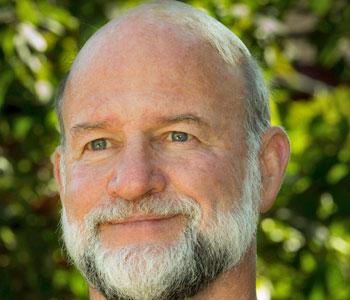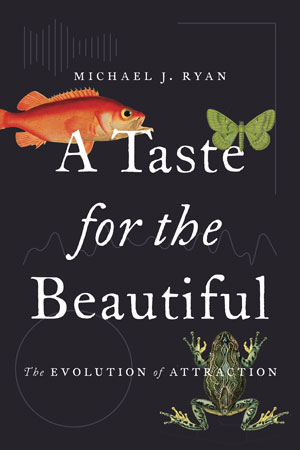
Stunning beauty abounds in nature. We see it everywhere we look. The brilliant colors and dances of butterflies and fishes, the songs of crickets, frogs, and birds, and even the odors of moths and mammals are all part of nature’s astounding collage of beauty. We humans are so attracted to animal beauty that we domesticate it for our own enjoyment. The multi-hued fishes in aquariums and melodious canaries in cages provide live art and music in our homes, much as we hang painting on our walls and broadcast tunes from our stereos.
But animals did not evolve beauty to please us; their aim is to please their own. Indeed, the most stunning beauty in nature is tied up in sex, as animals evolve beautiful and often elaborate traits in order to make themselves more attractive as mates, thereby increasing their reproductive success—this is the theory of sexual selection, first articulated by Darwin.
Darwin puzzled over how animals judge and perceive beauty. Why do animals perceive certain traits as beautiful and others not? Do animals possess an inherent sexual aesthetic? Where is this aesthetic rooted? What might unlocking the mysteries of sexual aesthetics tell us about the evolution of beautiful traits and our own perception and appreciation of beauty?
In this book, I argue that beauty is determined by what is happening in the brain. In short, beauty is in the brain of the beholder! Drawing on recent studies in neuroscience and evolutionary biology, I argue that sexual aesthetics are rooted in the brain—specifically the female brain—and that many of the details of what we find beautiful actually derive from other things the brain evolved to do. I describe what it is about the senses, the brain, and its cognitive architecture that leads to an appreciation for beauty among animals, including humans.
I had always been struck by beauties in animals, whether that be the extravagantly colored fish in my childhood aquarium, the long-tailed ornamental pigeons we raised as teenagers, or the cacophony of frog choruses I was introduced to as a college student. Thus, it was no surprise that I seem destined to study animal behavior and evolution.
Each of the more than 5000 species of frogs has its own mating call that males sing endlessly during the breeding season to attract females. We know that the brain of females was tweaked by evolution so females find the calls of their own males more attractive than the calls of males of other species.
To my ear, however, even males of the same species sound a bit different from one another. Yes, they all sound like the same species but some males call faster, have deeper voices, or add acoustic ornaments to their calls. Does all of this variation mean anything to the females? By combining observations in tropical rainforests, experiments in which females were “asked” to tell us which calls they preferred, and neurobiological studies of the female brain, we began to understand that not only do males sound different from one another but the females’ aesthetic preferences for certain sounds drive the evolution of these sexual displays. We now know that the females’ aesthetic preferences drive the evolution of all kinds of sexual beauty in the animal kingdom.
We also now know that animals have “hidden preferences.” The sexual brain contains an “unexplored landscape” of such preferences. There are many traits that the female brain would find attractive but males have yet to evolve these traits. This is not idle speculation: I review numerous studies that detail how males evolve traits that match these previously hidden preferences. I then turn to our own species and discuss how various items from Barbie dolls to pornography result from our own search to uncover our own hidden preferences.
Not only can preferences be hidden, but when they are drawn out of hiding and begin to be expressed we see that they can also be quite fickle. I explain how biological clocks, as well as the closing time at bars, influence how females assess the attractiveness of potential mates. Peer pressure is another potent force promoting fickleness. Although we are all familiar with peer pressure, the reader will be surprised at the degree to which our social milieu can so quickly change our view of beauty, and how the same thing happens in fishes, birds, and mammals.
I apply this brain-based perspective to consider our own appreciation for “beauty” in a grander sense, as it applies beyond sex. Why is a rainbow “beautiful,” why does the mere refraction of light into bands of color inspire awe? Viewing beauty in all domains through the brain is bound to give us a better understanding of why beauty matters so much.
The first two chapters set the stage for understanding how beauty comes to be in the brain of the beholder. I begin Chapter 1 by asking a simple question: Why all the fuss about sex? Why can’t sex happen without all the courtship, seduction, and cajoling? Why have males evolved elaborate colors, dances, odors, and songs to impress females? And why is it that females are usually the ones who decide who gets to mate? Most readers will be amazed to learn the basic answer is that females have fewer, larger gametes and males have many smaller ones. Most of the differences between males and females of most animals are derived from this basic biological difference in gamete size between the two sexes.
Now that we know that females are in the driver’s seat when it comes to choosing a mate, in Chapter 2 I explore how it is that the brain perceives beauty. It all starts with biases in the sense organs that determine the sights, sounds, and smells that an animal perceives, and it culminates in the brain where judgments about beauty are made. The brain is important for sex, but it has other things on its mind. I wrap up Chapter 2 by showing the reader how other tasks of the brain, such as the need to detect food and predators, the way sights, sounds, and smells are processed, and the cognitive algorithms used to compare mates, all contribute to the female’s sexual aesthetics, to her taste for the beautiful.
In both of these chapters we are introduced to a conundrum that led Darwin to declare, “The sight of a feather in a peacock’s tail, whenever I gaze at it, makes me sick!” Darwin had been working on his theory of natural selection, which explains how organisms evolve adaptations for survival. But now he was confronted by the sexual beauty of male animals in which it was clear these traits, like the peacock’s tail, were not tools for survival, but in fact they hindered it. A male peacock extending his tail to its full length and vibrating it in front of the female while courting her looks quite majestic, but when that same male is being chased by a predator he appears quite pathetic and barely even to fly with such a cumbersome accoutrement trailing behind him.
Similarly, in the frogs that I study, males add syllables called chucks to the introductory whine of the mating call. Females are attracted to calls that have only whines but they prefer calls with chucks, the more chucks the better. Why don’t males always produce calls with more chucks?
We discovered that the fringe-lipped bat eats frogs and finds them by homing in on the frog’s mating call. Like the female frogs, the frog-eating bats are attracted to calls that contain only whines, but prefer calls with chucks. This illustrates the basic conflict involved in the evolution of sexual beauty: natural selection favors traits that enhance survivorship, while sexual selection favors traits that enhance sexual attraction. The result is usually some compromise between the two.

Beauty is all around us and it is intoxicatingly diverse. Much of this diversity exists because beauty enters our sexual brain through different sensory modalities, which strains our ability to make comparisons: we cannot objectively rank the beauty of a dance, a song, and a fragrance. The diversity of beauty is no less astounding within a single sensory domain—the collage of colors of many fishes and the vocal repertoires of songbirds are both overwhelming. The existence of all this diversity makes it obvious that there is no single platonic ideal of beauty. This is true within our own species and also amongst the hundreds of thousands of species that reproduce sexually. The diversity of beauty springs from the diversity in how different species and even individuals of the same species sense the world around them. Our sexual aesthetics, those of humans and other species, are not handed down from above but are generated from within, specifically from within our brains. We are the ones who define beauty, and understanding the existence of beauty as well as our taste for it is not possible without viewing beauty through the brain of the beholder.
Of course, beauty is not restricted to sexual beauty. The perspective I present here also leads us to wonder how the idiosyncrasies and quirks in our own brains influence our own appreciation of a work of art, a field of flowers, or an expertly executed move on the football field. Might any of these percepts of beauty be a side-effect of our sexual aesthetics? Or, alternatively, can our appreciation of beauty in other domains influence what we find to be sexually beautiful? What is it about our senses, our brains, and our cognitive architecture that gives us an appreciation for beauty all around us? Why does beauty matter so much?
Like Darwin, we will continue to be confounded by aspects and elements of beauty as we encounter them, but we have come to understand so much more about the evolution of beauty since his time. As scientific exploration continues, we are sure to expand even further our ability to see the ways that beauty is woven into existence, the many forms it assumes, and the wild appreciations it elicits.


Michael J. Ryan is the Clark Hubbs Regents Professor in Zoology at the University of Texas, Austin, and a Senior Research Associate at the Smithsonian Tropical Research Institute in Panama. Ryan received his Bachelor’s degree at Glassboro State College, his MS at Rutgers University, his PhD at Cornell University, and was a Miller Postdoctoral Fellow at the University of California, Berkeley. Ryan is a fellow of the American Academy of Arts and Sciences, the American Association for the Advancement of Science, the Guggenheim Foundation, and the Institute of Advanced Studies in Berlin.